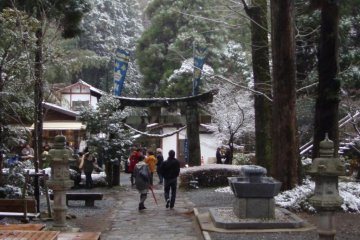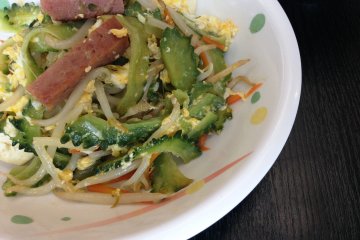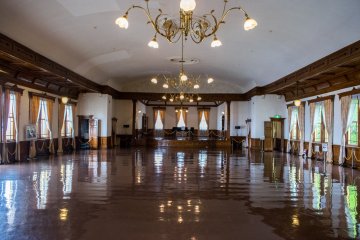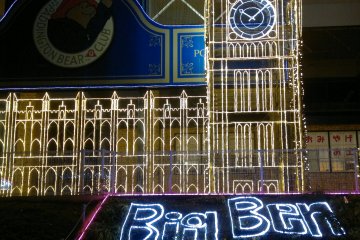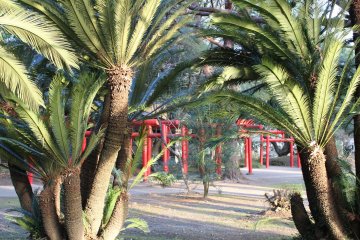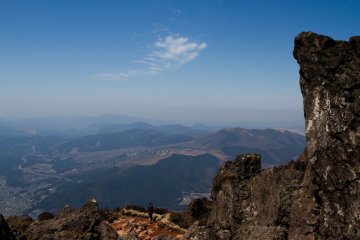Leave the crowds behind and head for a rural gem of Kyushu, the small town of Nobeoka. At the midpoint of Kyushu’s Pacific coast, pristine water flows from the rocky peaks, down the deep canyons, through the city, and out to the sandy beaches and coral reefs. After a day soaked in natural beauty, content yourself back in the city with the area’s hearty food, fine beverages, and historic masterpieces.
1. Search for Rare Flora and Fauna in Sobo-Katamuki Quasi-National Park

Just thirty minutes from downtown, you’re surrounded by mountains capped with peaks of sheer, exposed rock and gorge-ous valleys littered with massive boulders and covered in lush forest. This is a UNESCO biosphere reserve. Precious endemic animals and plants live here, such as the Japanese serow (a kind of goat-antelope), the great purple emperor (the national butterfly of Japan), and the yellow wax bells (a member of the hydrangea family with small trumpet-like yellow flowers blooming in late summer).
- How to get here: Buses from Nobeoka Stn. to Hourikawa Onsen leave twice daily (1 hr, 10 min; ¥500). Best reached by car taking Prefectural Rt. 207 from Nobeoka. By car, the Mt. Kamisan trailhead is 2 min past the onsen, and the Mt. Ohkue trailhead is 13 min further. Due to the ruggedness of the trails, a guide is recommended.
- More info: Sobo, Katamuki, and Okue Biosphere Reserve Promotion Council.
2. Rock Climbing, Bouldering, and Canyoning

Parts of Sobo-Katamuki have distinctive geophysical landscape reminiscent of Yosemite and are a mecca for rock climbers. Mt. Hiei is perhaps the most famous, but mammoth boulders, canyons, and cliffs of stone abound here. Each winter attracts ice climbers to the area’s frozen waterfalls. Even if you’re not climbing, the geometric monoliths are fantastic photo-ops, such as Pac-Man Rock (Pakkun-iwa).
- How to get here: The Shishi River Campground is 1 hr, 20 min from downtown Nobeoka by car along National Rt. 218 and Prefectural Rt. 214; Pac-Man Rock is a short hike from there, but a guide is recommended for safety as trails can be dangerous.
- More info: Explore Nobeoka (Nobeoka City).
3. Trekking to Mt. Ohkue

The Kamihouri Trail through the beautiful Houri River Valley takes you along one of Kyushu’s most secluded and rugged footpaths to the peak of stone-faced Mt. Ohkue (1644 m). After the grueling day-long hike, near the trailhead, soak-in your memory of these mountains with the relaxing Bijin-no-yu (“beauty bath”), a natural hot spring at Hourikawa Onsen. Around the corner from the onsen, spend the night in a log cabin or pitch a tent right next to the rumbling river at the campground.
- How to get here: Buses from Nobeoka Stn. to Hourikawa Onsen leave twice daily (1 hr, 10 min; ¥500). Best reached by car taking Prefectural Rt. 207 from Nobeoka. By car, the Mt. Kamisan trailhead is 2 min past the onsen, and the Mt. Ohkue trailhead is 13 min further. Due to the difficulty level of the trails, a guide is recommended.
- More info: Sobo, Katamuki, and Okue Biosphere Reserve Promotion Council. Nobeoka has a large number of hiking trails, some very challenging.
4. Canoeing in Crystal-Clear River Valleys

Getting deeper into the flow of things here is a good thing, for the water is far beyond the ordinary. These streams rank at the top of Japan’s clearest—perfect for kayaking, canoeing or rafting. Going during firefly season (late May through early June) comes highly recommended.
- How to get here: Nobestar provides boats and guides.
- More info: Nobestar (the river boating season runs April through August).
5. Fish and Japan’s Longest Fish Trap

Fishing for tasty yamame (cherry salmon) or ayu (sweetfish) in these mountain torrents is also a popular way to relax in nature. If you like the fish more than the fishing, check out the huge traditional wooden ayu trap back in the city from late October through December 1. The ayuyana has spanned the Ose River annually for three centuries. The structure is one of Japan's biggest, and there’s a seasonal restaurant right next to it serving the catch in epicurean fashion.
- How to get here: The ayuyana operates from late October through December 1 (map); take a bus (15 min, ¥370) or taxi (7 min, ¥910) from Nobeoka Stn. For fishing (permit required), Nobestar will provide gear.
- More info: Explore Nobeoka for the ayuyana. Nobestar for mountain stream fishing and ocean fishing.
6. Beautiful Sandy Beaches

Southern Kyushu is known for its beaches throughout Japan, and Shimoaso Beach is ranked by the government as the best swimming beach in Kyushu. Other notables include nearby Kumanoe and Sumie Beaches. Miyazaki’s Pacific Ocean waves are good enough to bring in international surfing competitions as well. If you want to stay above water, the coastline’s rugged features make for interesting sea cruises and scenic drives. Experience any of Nobeoka’s mountain and sea activities with a guide and equipment from Nobestar, an NPO corporation that connects you to local experts.
- How to get here: Shimoaso Beach: Take number 60/61 bus from Nobeoka Stn. bound for Miyanoura (48 min, ¥860). Get off at Shimoaso (map). Michi-no-eki Kitaura is here, too.
- More info: Nobestar provides surfing lessons
7. The Mitsukura—Nobeoka’s “Big Three” Makers of Beer, Shochu, and Sake

Miyazaki Hideji Beer, one of Japan’s premiere microbreweries, brews out at the foot of Mt. Mukabaki’s rocky twin peaks, split by a 77-m waterfall—a stunning location that makes use of the delicious clear water of Nobeoka. Their Kuri-kuro, a dark chestnut ale, took first place for stouts and porters at the World Beer Awards in 2017, and all their premium regular and seasonal brews can be enjoyed on site. The Sato shochu distillery is also worth visiting at their picturesque riverside location in the countryside, where they’ve been at work for over a century. Finally, the Sentoku sake brewery in Nobeoka City has a shop with their whole catalog of nihonshu brewed on site, including many award-winners.
- How to get here: The Hideji Brewery is a 25-min drive or taxi ride from the city center, the Sato distillery lies on the way to the Houri River Valley (Rt. 207), and the Sentoku brewery is downtown (map).
- More info: Explore Nobeoka.
8. Culinary Delights: Chicken Nanban, Karamen, and Spiny Lobster

Chicken nanban can be found throughout Japan, but it was invented here fifty-some years ago. It’s a type of fried chicken lightly dipped in sugared vinegar and accompanied by a special tartar sauce. It comes in two main varieties (using thigh or breast meat), and restaurants throughout the city serve it—but . . . the recipe varies from chef to chef. So, connoisseurs will enjoy comparing the distinctive flavors and styles that are best tasted here. Other culinary highlights include karamen, a bowl of noodles in spicy broth, and locally-caught spiny lobster.
- How to get here: Nobeoka’s specialties can be found throughout the city.
- More info: Explore Nobeoka.
9. Noh by Firelight at the Nobeoka Castle Ruins

Shiroyama Park in downtown Nobeoka contains the castle ruins, which date back to 1603—the year Hamlet was published. But this city has its own dramatic treasures in a collection of 66 spectacular Noh masks. Kept for centuries by the lords of the castle, 30 of these are known as “Tengaichi” and are considered masterpieces. For one night only (October 12 in 2019), the genuine articles come out in a rebirth of tradition at the base of the colossal castle wall known as the “Killer of a Thousand Men.” It’s an unforgettable Takigi-noh (firelight) performance under the stars that recreates the traditional coming-together of all walks of life in one audience. The play’s accompanied by a bustling market on October 12 and 13 that includes Nobeoka’s specialties and more.
If you visit after the performance, you can still see the masks along with other items of local historic interest usually displayed at the Naito Memorial Hall (after the renovation is complete). And in November, the castle also hosts the Kagura Festival, where you can witness theatrical Shinto dances similar to Noh. Depending on the season, cherry blossoms and wild camellias also flower within the castle walls.
- How to get here: Shiroyama Park is in the city center next to City Hall (map).
- More info: Nobeoka Tengaichi Taikigi Noh. Explore Nobeoka. Food market: Nobeoka Chisan Chikatsu Marche.

Nobeoka can be visited in a day or two—or several days for those looking to get into serious trekking, rock climbing, surfing, or diving. Off the beaten path yet an excellent destination, now’s the time to get to Nobeoka . . . before the secret’s out.

























